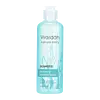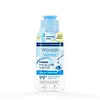What's inside
What's inside
 Key Ingredients
Key Ingredients

No key ingredients
 Benefits
Benefits

 Concerns
Concerns

 Ingredients Side-by-side
Ingredients Side-by-side

Water
Skin ConditioningPEG-6
HumectantCaprylic/Capric Glycerides
EmollientPropanediol
SolventBiosaccharide Gum-2
Skin ConditioningOlive Oil PEG-7 Esters
EmollientPropylene Glycol
HumectantPanthenol
Skin ConditioningCetrimonium Bromide
AntimicrobialDisodium EDTA
Cucumis Sativus Fruit Extract
EmollientUlva Lactuca Extract
Skin ConditioningGlycerin
HumectantPotassium Sorbate
PreservativeSodium Benzoate
MaskingWater
Skin ConditioningCyclopentasiloxane
EmollientIsohexadecane
EmollientDicaprylyl Carbonate
EmollientHexylene Glycol
EmulsifyingNiacinamide
SmoothingOlive Oil PEG-7 Esters
EmollientParaffinum Liquidum
EmollientSodium Chloride
MaskingPhenoxyethanol
PreservativeCyclotetrasiloxane
EmollientPrunus Amygdalus Dulcis Protein
Skin ConditioningAllantoin
Skin ConditioningCetrimonium Bromide
AntimicrobialBenzalkonium Chloride
AntimicrobialDisodium EDTA
Ethylhexylglycerin
Skin ConditioningPropylene Glycol
HumectantCucumis Sativus Fruit Extract
EmollientDecyl Glucoside
CleansingMacadamia Ternifolia Seed Oil
EmollientGlycine Soja Oil
EmollientPersea Gratissima Oil
Skin ConditioningSimmondsia Chinensis Seed Oil
EmollientParfum
MaskingBisabolol
MaskingIsobornyl Acetate
MaskingCalendula Officinalis Flower Extract
MaskingChamomilla Recutita Flower Extract
MaskingFucus Vesiculosus Extract
EmollientTriticum Vulgare Bran Extract
Skin ConditioningBHT
AntioxidantLinoleic Acid
CleansingTocopherol
AntioxidantCI 61565
Cosmetic ColorantWater, Cyclopentasiloxane, Isohexadecane, Dicaprylyl Carbonate, Hexylene Glycol, Niacinamide, Olive Oil PEG-7 Esters, Paraffinum Liquidum, Sodium Chloride, Phenoxyethanol, Cyclotetrasiloxane, Prunus Amygdalus Dulcis Protein, Allantoin, Cetrimonium Bromide, Benzalkonium Chloride, Disodium EDTA, Ethylhexylglycerin, Propylene Glycol, Cucumis Sativus Fruit Extract, Decyl Glucoside, Macadamia Ternifolia Seed Oil, Glycine Soja Oil, Persea Gratissima Oil, Simmondsia Chinensis Seed Oil, Parfum, Bisabolol, Isobornyl Acetate, Calendula Officinalis Flower Extract, Chamomilla Recutita Flower Extract, Fucus Vesiculosus Extract, Triticum Vulgare Bran Extract, BHT, Linoleic Acid, Tocopherol, CI 61565
Ingredients Explained
These ingredients are found in both products.
Ingredients higher up in an ingredient list are typically present in a larger amount.
Cetrimonium Bromide is a preservative.
This extract comes from cucumber. Cucumbers are mostly made up of water (95%), and the other 5% is composed of: vitamin C, caffeic acid, fatty acids, amino acids, and other minerals.
Cucumbers have anti-inflammatory, barrier repair, and hydrating properties.
They contain shikimate dehydrigenase, an enzyme shown to help reduce inflammation and soothe the skin.
The amino acids found in cucumbers help nourish our skin's natural acid mantle (it's an important part of our skin barrier). This slightly acidic film acts as a barrier to protect us from bacteria, viruses, and other contaminants.
Unless you have an allergy to cucumbers, this is generally a non-irritating ingredient.
Fun fact: Cucumis Sativus is native to South Asia and can now be found on every continent.
Learn more about Cucumis Sativus Fruit ExtractDisodium EDTA plays a role in making products more stable by aiding other preservatives.
It is a chelating agent, meaning it neutralizes metal ions that may be found in a product.
Disodium EDTA is a salt of edetic acid and is found to be safe in cosmetic ingredients.
Learn more about Disodium EDTAPropylene Glycol is an odorless, colorless liquid. As a humectant, it helps skin retain moisture. It also aids in delivering active ingredients.
Another role of this ingredient is preventing a product from melting or freezing. Propylene glycol also adds antimicrobrial properties to a product, elongating product lifespan.
This ingredient is considered an organic alcohol and commonly added into both cosmetics and foods.
Those with sensitive skin or conditions may develop a rash when using this ingredient.
Learn more about Propylene GlycolWater. It's the most common cosmetic ingredient of all. You'll usually see it at the top of ingredient lists, meaning that it makes up the largest part of the product.
So why is it so popular? Water most often acts as a solvent - this means that it helps dissolve other ingredients into the formulation.
You'll also recognize water as that liquid we all need to stay alive. If you see this, drink a glass of water. Stay hydrated!
Learn more about Water